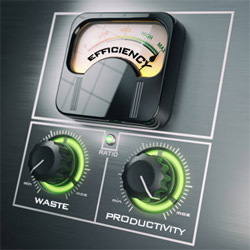by Joe Connelly , Product Manager – Winding and Slitting

In two previous articles, lay-on rollers were discussed. From the evolution of the lay-on roller to the advantages of the more modern linearly-acting lay-on roller and minimum gap configurations to improve winding and web handling performance. Now the discussion will focus on the advantages of having predictable web tension and lay-on nip controls within this type of lay-on roller system.
You may recall that when tensile forces are applied to a piece of material, the resulting change in length, divided by its initial length, is the definition of strain, a non-dimensional measurement of how much the material has been stretched. Research has shown that maintaining a uniform strain in a web as it is being conveyed in a machine can lead to improved web control. The forces acting on the web must be predictable and uniform to ensure finished roll quality. In the case of a slitter rewinder, this uniformity applies to each slit strand and wound package, which requires both mechanical and electrical accuracy and robustness. Maintaining a constant relationship between a lay-on roller’s position with respect to its mating winding roll achieves more predictable winding results.
Converting operations that must constantly change the setup of their slitter equipment to meet their ever-changing production schedules cannot afford the time and material needed to establish proper operating conditions for the next run. There usually isn’t enough time or material to experiment with various settings and adjustments to establish the correct lay-on roller conditions to process the new material. Knowing what settings should be run is one thing that an experienced operator provides. But what if the experienced operator isn’t around to setup the machine? This is where having predictable web tension and lay-on nip controls can be a huge advantage.
Having a machine that is fundamentally easier to setup and run, and is not as dependent on the finesse or skill level of the operator to produce quality product can go a long way in reducing waste and improving overall productivity. The challenges that today’s materials present to the converter can more easily be overcome by processing them on equipment that allows materials with slight variation to be processed at higher speeds into high quality finished rolls, in larger sizes, with features that promote consistent web tracking and uniform finished roll formation.
In an upcoming series, we’ll discuss how the combination of uniform web path that maintains a constant winding geometry within the machine, along with modern controls technology, can lead to more predictable web handling results over a broader range of materials and operating conditions.